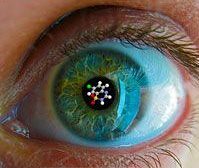In late March, Rikke Schmidt Kjærgaard (which several of us here at Medical Museion met when she gave a seminar here a couple of years ago and who is now working at the MRC Mitochondrial Biology Unit, University of Cambridge) is organising a meeting of great relevance for anyone interested in biomedicine on display, whether in museums or on the screen.
 Titled ‘Have you ever seen a molecule? Art, science and visual communication’, the two-day meeting at the Cambridge Centre for Research in the Arts, Social Sciences and Humanities (CRASSH), 25-26 March, concentrates on the correlation between art/design and molecular biology, in particular structural biology, and on the impact of the arts and artistic practices on scientific culture. Current molecular biological research is very dependent upon visualisation methods, both in the production of intepreted data and in the communication to other scientists and the public at large. The call for papers explains the relevance of this topical issue, both for scientists and for science communicators, understood broadly:
Titled ‘Have you ever seen a molecule? Art, science and visual communication’, the two-day meeting at the Cambridge Centre for Research in the Arts, Social Sciences and Humanities (CRASSH), 25-26 March, concentrates on the correlation between art/design and molecular biology, in particular structural biology, and on the impact of the arts and artistic practices on scientific culture. Current molecular biological research is very dependent upon visualisation methods, both in the production of intepreted data and in the communication to other scientists and the public at large. The call for papers explains the relevance of this topical issue, both for scientists and for science communicators, understood broadly:
Despite the fact that structural images of individual projects are made by thousands of researchers in laboratories around the world, there is as yet no general consensus on what makes a good image. Consequently, there is no obvious and necessary correlation between the images made for pragmatic and heuristic purposes in the laboratory, those chosen for posters and conference presentations, the images accompanying article submissions, and finally those that will be selected or further designed for public engagement and communication. Instead, how specific traits should be visualised, which colour schemes should be applied and how to pick the perfect image for specific purposes depend to a large degree upon pragmatic categories and local factors within individual laboratories and research groups, as well as on editorial decisions and a stronger promotional value, at least to some degree independently of scientific preferences and arguments.
Interdisciplinary collaboration in visualising molecular structures lies at the very core of contemporary research processes and products. Bringing art, design and science together is far more than just an interesting experiment in transdisciplinary cross-communication, it is a necessary step in exploring new ways of optimising imagery at the molecular level and thus breaking new ground. We depend upon this in the arts as well as in the sciences in the future university to make things better and to advance our knowledge of life at a molecular level.
Rikke/CRASSH welcomes submissions for presentations broadly within visualisation of science. Send a <250 words abstract, a brief CV and a few lines about your interest in the conference before 1 February 2010 to rsk@mrc-mbu.cam.ac.uk (and please use the form here).
Registration fee (includes catering) is a bargain (£30 for faculty, £15 for students.). Registration will be available from the conference website shortly.
